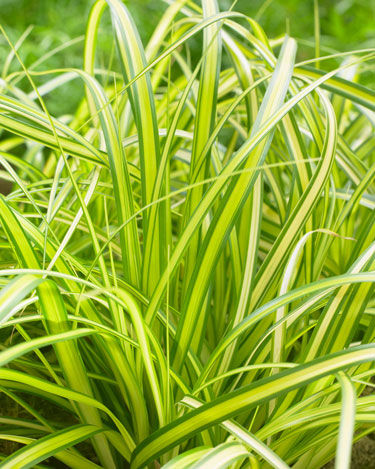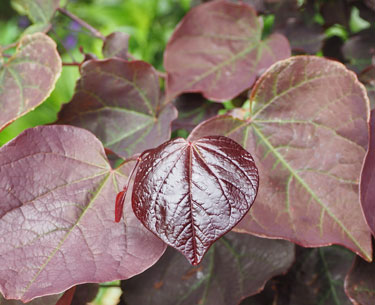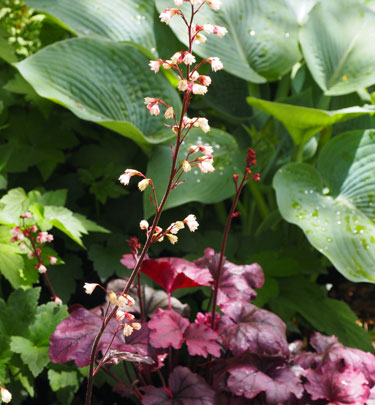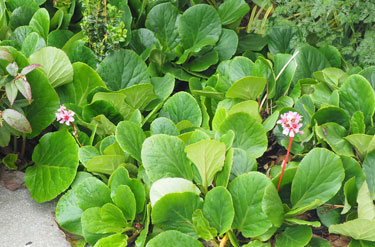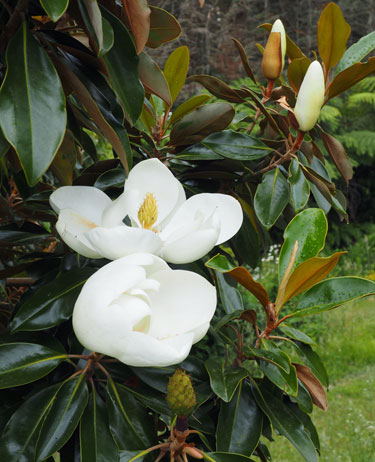| 1 |
Japanese maples (Acer)
In spring and autumn the Japanese maples are some of the most colourful little trees in the garden and beautiful near water. Leaf forms range from the classic five finger shape to finely divided lacy leaf forms on cascading branches. Plant them where they are sheltered from strong winds. With lots of small growing varieties to choose from, they are prefect for smaller gardens or as a feature in a large pot. |
| 2 |
Carex
Easy-care sedges bring contrasting texture and movement. The shiny variegated leaves and attractive flowing forms of Japanese sedges are outstanding accent plants for pots. Carex ‘Eversheen ’ in deep green with a lime yellow stripe is a vibrant addition to shade gardens. Graceful cascading ‘Feather Falls’ delights in crisp white and green with beautiful feathery flower plumes in spring. |
| 3 |
Canna
Bold tropical canna leaves are striking in plain green and even more so when they are dramatically striped in tones of cream, yellow, orange or red. Show stopping cultivars include ‘Tropicanna ’ and ‘Tropicanna Gold ’ . |
| 4 |
Cercis ‘Forest Pansy’
This tidy little tree is loved for its rich purple tones and large heart shaped leaves that turn vibrant oranges and reds in autumn. It has an attractive spreading habit and sits beautifully in the company of hostas, heucheras and spring bulbs. |
| 5 |
Heuchera and Heucherella
With their astounding variety of colours, heucheras and heucherellas are favourites for mass planting, pots and hanging baskets. They are reliable and easy to grow and ideal as low maintenance groundcover in shady places, tolerating periods of dryness. Grown mainly for their handsome evergreen foliage, it is their pretty flowers that are responsible for their common name, ‘coral bells’. Slugs and snails are not a great threat but watch for thrips in dry weather. |
| 6 |
Hosta
Hostas are famous for the beauty of their leaves. Use them to add depth and dimension to a shady planting scheme or as a statement in a large pot. As moisture-loving plants, they thrive alongside ponds and streams. Hostas are deciduous perennials, disappearing from view in winter. But this means they ’re cold hardy and able to thrive in a wide range of climates, emerging fresh and new from the ground spring after spring. Hosta’s countless leaf forms range from smooth to heavily textured, corrugated, or puckered. Some are heart-shaped, others lance-shaped, oval, or elongated. Some leaves are quite small, and some very large. Colours feature bright chartreuse tones through forest greens, cool blues and silver greys, with many spectacular variegated forms adding tones of white, cream and gold. |
| 7 |
Ligularia
Ligularias (also called Fargugium) stand out with their big kidney shaped leaves. They’re perfect for moist well drained soil in dappled shade. Favourites include the big shiny ‘tractor seat’ leaves of Ligularia reniformis, spotted leopard plant (L. japonicum ‘Aureomaculatum'), creamy variegated Ligularia tussilaginea 'Aureo-maculata' or dark chocolate and purple ‘Britt-Marie Crawford ’. Protect young plants from slugs and snails. |
| 8 |
Ferns
Some our most underused garden plants are enjoying a comeback as we realise their great versatility. There are ferns for any NZ climate, from frosty to subtropical. Perfect for cool sheltered spaces, they blend beautifully with hostas and other shade loving perennials. |
| 9 |
Brunnera
The silver speckled foliage of Brunnera 'Jack Frost’ lights up a shady corner with its pretty heart shaped leaves. This cold hardy woodland perennial produces dainty blue for-get-me-not flowers in spring. Slowly spreading via underground rhizomes, it makes an excellent groundcover under trees. |
| 10 |
Pulmonaria
Like the Brunneras, Pulmonarias belong to the borage family. Their small blue, pink or white spring flowers are the icing on the cake in spring, but their attractive silver-speckled leaves are beautiful in their own right. These compact, easy-to-grow perennials are great as groundcover in part shade. Pulmonaria ‘Raspberry Splash’ is a robust grower with silver speckled, lance shaped foliage and bright pink blooms. |
| 11 |
Ajuga
Ajugas are robust mat-forming perennials that stand up to competition at ground level, their tight growth a tough evergreen defence against weeds. All thrive in shade or part shade. ‘Caitlins Giant ’ , ‘Royalty’ and ‘Jungle Beauty ’ are the larger leaf forms.‘Chocolate Chip’ is a small leaf form ideal along edges and between pavers. Glossy dark ‘Black Scallop ’ will tolerate more sun than the greener Ajuga varieties. Compact flower spikes in blue, pink or white add an extra layer of interest in summer. |
| 12 |
Bromeliads
Bromeliads are the ultimate collectors' plants with literally hundreds to choose from over several different species, from tiny Tillandsias to massive Alcantareas. Their dramatic forms, striking foliage and bold colours are often enhanced with exotic flowers. Most are adaptable to sun or shade, but for best results, check individual preferences. |
| 13 |
Ginkgo
With distinctive kidney-shaped bright green leaves, Gingko trees are among the most ancient on earth. Modern cultivars offer a surprising diversity of choice for town-sized gardens, including the popular dwarf varieties, ‘Jade Butterflies’ and ‘Ming Princess’ to tall and narrow ‘Fastigiata’. |
| 14 |
Bergenia
Easy care, drought tolerant and eye catching with their huge green leaves, bergenias make excellent groundcover plants in sun or shade. There are lots of different varieties all with attractive winter and spring flowers in pink or white. |
| 15 |
Aeonium
‘Rosette’-forming succulents produce striking leaves in the shape of flowers. They are some of the easiest to grow plants for hot dry gardens or pots. Low growers Echevaria and Sempervivum are excellent as ground cover and narrow borders. A taller grower with striking rosettes is stunning Aeonium Schwarzkopf with dark purple, almost black leaves. |
| 16 |
Magnolia grandiflora
The attractive leathery leaves of the evergreen magnolias, glossy dark green on top and velvet brown beneath make excellent vase fillers all year round. Among the best as garden trees are Magnolia grandiflora ‘Kay Parris ’ and ‘Little Gem ’ . The large cream scented flowers delight over summer and autumn. |
| 17 |
Parsley
This simple garden herb is a mainstay for kitchen gardeners but also worth planting for its pretty bright green foliage. It makes an excellent border for a vege garden or for an accompaniment to other herbs and flowers in pots or hanging baskets. Sow seeds or plant seedlings at least once a year for a year-round supply. |
| 18 |
Alchemilla
Alchemilla mollis aka Ladies Mantle is most beautiful just after a rain shower when the raindrops sit like glassy pearls on its soft green leaves. The circular leaves form a tight clump useful as edging. Clouds of lime green flowers appear in summer. |
| 19 |
Sedum
There are lots of different sedums offering excellent foliage contrast for hot dry places.
Loved for foliage contrast as well as late summer colour Stonecrop (Sedum spectabile) brings striking architectural form with its fleshy blue-green horizontal leaves on stout upright stems. The variety ‘Autumn Joy ’ is a long-standing favourite of many different varieties.
|
Striped, spotted and speckled
Adding a dash of variegated foliage to a planting scheme is like turning the lights on, especially in a shady part of the garden or on a dull wintry day.
The origins of variegation are complex and varied. Some are genetic and passed on via seed, but most arose as a chance mutation and must be reproduced via vegetative means, not seed.
Because they have less chlorophyll, most variegated plants grow more slowly and not as large as their plain green versions. This can be a very useful thing in a small garden or when planting in containers. Many grow best where there is protection from hot sun.
Use variegated plants as spotlights, not floodlights. Overuse them and your garden will wind up looking washed out and sickly.


